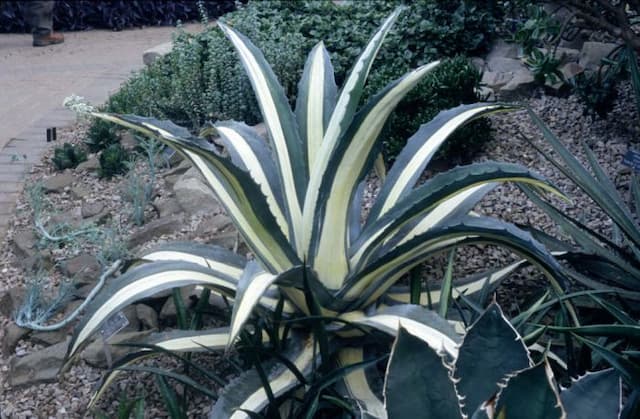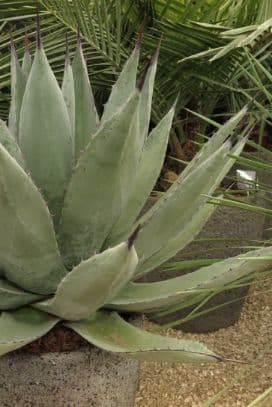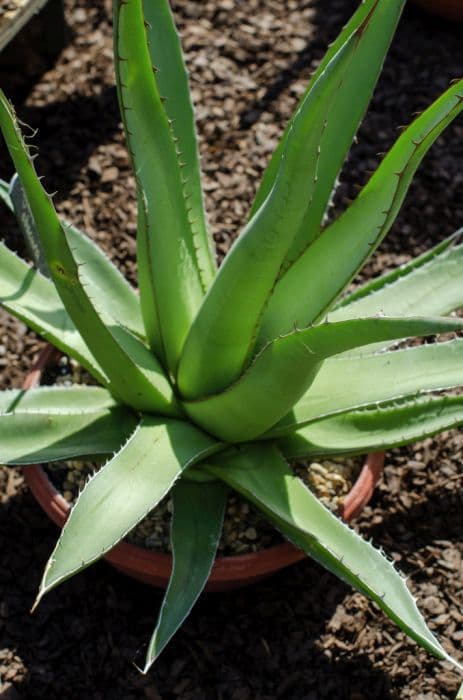Grape Hyacinth Muscari azureum 'Bling Bling'

ABOUT
Muscari azureum 'Bling Bling', commonly known as the Azure Grape Hyacinth, is a delightful bulbous perennial that adds a touch of sparkle to the spring garden. This cultivar is known for its dense clusters of small, urn-shaped flowers that resemble tiny grapes. The flowers are a striking shade of bright to deep blue, sometimes with a silvery sheen that gives the 'Bling Bling' variety its sparkling name. The blooms are tightly packed along the upright flower spikes and appear above the plant's foliage, creating a bold contrast. The leaves are narrow, strap-shaped, and a fresh green color, which nicely complements the blue flowers. As a member of the Lily family, the Azure Grape Hyacinth emits a sweet, light fragrance that adds to its charm during its blooming season. The overall form of the plant is compact and rounded which makes it attractive for grouping together as a feature in a garden bed, border, or container display. Additionally, these plants are often noted for their ability to naturalize and spread over the years, creating drifts of blue in the landscape.
About this plant
 Names
NamesFamily
Asparagaceae.
Synonyms
Azure Grape Hyacinth, Blue Bottle, Bling Bling Muscari.
Common names
Muscari azureum
 Toxicity
ToxicityTo humans
The commonly known grape hyacinth is generally not considered toxic to humans. Ingestion of plant parts of the grape hyacinth, such as the bulbs which are often mistaken for onions, primarily causes mild stomach upset if consumed. Despite its relative safety, it should not be eaten and one should always exercise caution and keep plants out of the reach of children who may inadvertently ingest plant material.
To pets
The commonly known grape hyacinth is considered to be mildly toxic to pets, such as cats and dogs. If a pet ingests parts of the grape hyacinth, especially the bulbs, it may experience symptoms of gastrointestinal upset, including vomiting and diarrhea. If you suspect your pet has ingested any part of the plant, it is important to consult a veterinarian for appropriate care and to avoid more serious health problems.
 Characteristics
CharacteristicsLife cycle
Perennials
Foliage type
Deciduous
Color of leaves
Green
Flower color
Blue
Height
6 inches (15 cm)
Spread
3 inches (7.5 cm)
Plant type
Bulb
Hardiness zones
4
Native area
Middle East
Benefits
 General Benefits
General Benefits- Enhances Garden Aesthetics: With its vibrant blue flowers, Muscari azureum 'Bling Bling' adds a splash of color to any garden space.
- Spring Blooming: This plant is a herald of spring, providing early-season blooms that brighten up the garden after winter.
- Attracts Pollinators: The flowers provide nectar for bees and other pollinating insects, supporting biodiversity.
- Low Maintenance: Once established, it is relatively low maintenance, requiring minimal care beyond occasional watering and feeding.
- Naturalizes Easily: It can spread and naturalize in the garden, filling up spaces with its colorful blooms.
- Drought Tolerant: After becoming established, it has good drought tolerance, making it suitable for drier climates or periods of low rainfall.
- Deer and Rodent Resistant: Known to be resistant to deer and rodents, it can be a hassle-free choice for gardens with wildlife challenges.
- Container Gardening: Suitable for pots and containers, it allows for flexible garden design and can be used to decorate patios, balconies, and other small spaces.
- Ground Cover: Due to its growth habit, it can effectively act as a ground cover, suppressing weeds and reducing garden maintenance.
 Medical Properties
Medical PropertiesThis plant is not used for medical purposes.
 Air-purifying Qualities
Air-purifying QualitiesThis plant is not specifically known for air purifying qualities.
 Other Uses
Other Uses- Grape hyacinths can be used for fabric dyeing, particularly for obtaining shades of green and blue depending on the mordant used.
- In small gardens, grape hyacinth bulbs can serve as a living mulch under deciduous trees or shrubs, helping to suppress weeds.
- Grape hyacinths' dense growth habit can stabilize soil and reduce erosion on slight slopes or raised garden beds.
- When planted in containers, grape hyacinths can be used as a natural pest repellent by placing the pots near entry points to deter small rodents with their fragrance.
- Grape hyacinth flowers can be pressed and used in arts and crafts, such as making bookmarks or decorating homemade cards.
- Their vibrant blue color can provide a natural colorant for use in playdough or other non-toxic crafting materials for children.
- The flowers can be used to decorate cakes or pastries when crystallized with egg whites and sugar.
- Grape hyacinth stalks can be woven into small wreaths or garlands for springtime decorations.
- During blooming season, they can be used in photography to create vibrant and contrasting backdrops for macro photography subjects.
- Grape hyacinth can also be used in educational settings to demonstrate plant growth cycles and bulb propagation to students.
Interesting Facts
 Feng Shui
Feng ShuiThe Grape Hyacinth is not used in Feng Shui practice.
 Zodiac Sign Compitability
Zodiac Sign CompitabilityThe Grape Hyacinth is not used in astrology practice.
 Plant Symbolism
Plant Symbolism- Grape Hyacinth ('Muscari azureum' 'Bling Bling'): Symbolizes trust and sincerity due to its enduring and reliable bloom each spring. The deep blue color often represents stability and confidence.
- Beauty: With its delicate bell-shaped flowers, the Grape Hyacinth is often associated with beauty and the appreciation of it.
- Constancy: Grape Hyacinths return every year, often multiplying, which symbolizes constancy and the idea of everlasting relationships.
- Power: Despite its small stature, the Grape Hyacinth can represent power due to the boldness of its color and its ability to thrive in various conditions.
- New Beginnings: As one of the early bloomers in spring, it symbolizes rebirth and fresh starts, paralleling the season it blooms in.
 Water
WaterGrape hyacinths, including the Muscari azureum 'Bling Bling', require regular watering during their active growth in the spring. Water the plant when the top inch of soil feels dry to the touch, which may be about once a week, depending on weather conditions. Use room temperature water, avoiding getting the foliage wet to prevent fungal diseases. During the dormant period after blooming, reduce watering significantly to avoid rot. On average, you might use up to a gallon of water every two weeks for outdoor plants, but always adjust based on rainfall and soil moisture levels.
 Light
LightGrape hyacinths prefer full sun to partial shade. They thrive in a spot that receives at least 4 to 6 hours of direct sunlight a day. If you're planting them indoors, a south-facing window is an ideal location to ensure they receive enough light, but be wary of too much direct sun in hotter climates, which might require some afternoon shade.
 Temperature
TemperatureGrape hyacinths are hardy and can tolerate a wide range of temperatures. They can survive winter temperatures as low as 25°F but prefer a cooler period to bloom well, ideally between 35°F and 48°F for optimum growth. They can handle up to 75°F during their growth period in the spring but should be protected from extreme heat.
 Pruning
PruningGrape hyacinths typically do not require extensive pruning. After the flowers fade, you can deadhead the spent blooms to maintain a neat appearance and prevent self-seeding if desired. Do not cut back the foliage until it turns yellow and dies back naturally, as the leaves are needed to gather energy for the next blooming season.
 Cleaning
CleaningAs needed
 Soil
SoilGrape Hyacinths prefer well-drained soil with a neutral to slightly acidic pH of 6.0 to 7.0. A good mix would be two parts garden soil, one part peat moss or compost, and one part sharp sand or perlite to enhance drainage.
 Repotting
RepottingGrape Hyacinths typically do not require frequent repotting and can be repotted every 3-5 years or when they outgrow their current container.
 Humidity & Misting
Humidity & MistingGrape Hyacinths tolerate a wide range of humidity levels but prefer average household humidity. There's no need for any special humidity adjustments for this plant.
 Suitable locations
Suitable locationsIndoor
Ensure bright indirect light, cool temperature, and well-drained soil.
Outdoor
Plant in well-drained soil with full sun to partial shade.
Hardiness zone
4-8 USDA
 Life cycle
Life cycleMuscari azureum 'Bling Bling', commonly known as 'Bling Bling' Grape Hyacinth, begins its life cycle when a seed germinates, typically needing a period of cool temperatures to break dormancy. The plant develops a bulb from which foliage emerges in early spring, consisting of slender, green leaves. Flower spikes follow, showcasing the plant's distinctive blue flowers. After blooming, the plant goes into a period of dormancy during the summer months where the foliage dies back and the bulb conserves energy. In the fall, the bulb may produce offsets or daughter bulbs, which can be separated for propagation. The bulbs overwinter in the soil and the cycle begins anew with the return of spring.
 Propogation
PropogationPropogation time
Spring
Propogation: Muscari azureum 'Bling Bling', commonly known as Blue Grape Hyacinth, can be propagated primarily through division of its bulb clusters. The best time for this propagation method is in the fall, immediately after the foliage has died back, signaling that the plant is entering its dormant phase. To propagate, the gardener should carefully dig up the clusters of bulbs, gently separate the individual bulbs from the clump, and replant them immediately. Each separated bulb should be planted approximately 3 inches (about 7.6 cm) deep and spaced about 3 inches (7.6 cm) apart to allow room for growth. They prefer a location that has well-drained soil and full sun to partial shade. Through this simple division method, the Blue Grape Hyacinth will multiply, leading to a more bountiful display in the following spring.









